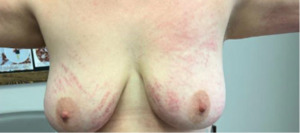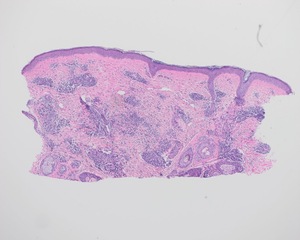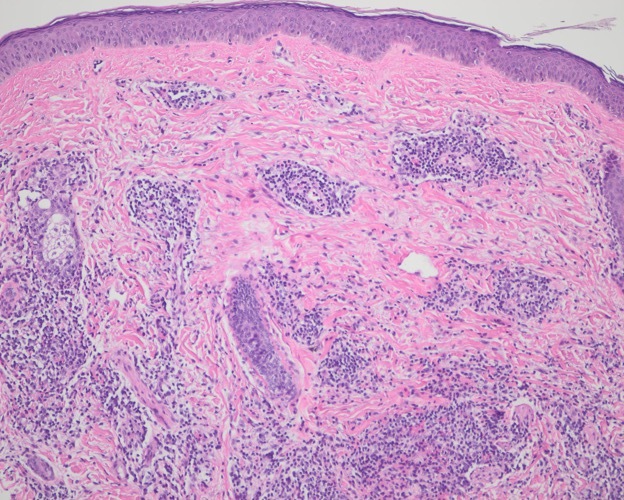Introduction
Shiitake mushrooms (Lentinula edodes) is the second most consumed mushroom in the world and is commonly used in Asian meals. Flagellate dermatitis, also known as shiitake dermatitis, was first reported by Nakumura in 1977. Nakumura reported 23 cases of shiitake dermatitis with similar physical manifestations after the consumption of shiitake mushrooms.1
Findings have been known to present after the consumption of raw or half-cooked shiitake mushrooms.2 The clinical manifestations of flagellate dermatitis are unique in that patients present with erythematous papules linearly scattered in a “whiplash” appearance primarily on the trunk and extremities with associated symptoms of severe pruritus.1
This case is unique in that this 33-year-old woman developed flagellate dermatitis without the consumption of shitake mushrooms, but after ingestion of a supplement containing sulfur. Flagellate dermatitis may arise from multiple exposures. Flagellated erythema was first described in relation to bleomycin treatment.3 Thereafter, it has been associated with peplomycin, adult-onset Still’s disease, and dermatomyositis.4 Two cases of flagellated erythema in association with cisplatin were described, and after infusion with docetaxel a whiplash pattern lesion was also reported.5,6
Case Synopsis
A 33-year-old woman with history of discoid lupus presented with flagellate dermatitis, severe pruritus, trouble breathing, and irritation. This rash negatively impacted her quality of life and daily activities with worsening of symptoms eight-days prior to presentation.
On physical examination, the patient presented with curvilinear streaked patches of dermatitis in a flagellate pattern on the breast, arms, chest, hips, and legs, as seen in Figure 1. A right temple punch biopsy was performed. In addition, Complete Blood Count (CBC), Complete Metabolic Panel (CMP), ANA comprehensive panel were obtained. ANA comprehensive, CBC, CMP were unremarkable, histopathological evaluation of the right temple punch biopsy revealed superficial and deep perivascular and periadnexal lymphocytic dermatitis most consistent with the clinical impression of Flagellate Dermatitis as seen in Figures 2A and 2B.
The patient denied consuming Shiitake mushrooms during her initial diagnosis. However, she reported taking three supplements: Sulfurzyme blend, Inner defense, and Omegagize from Young Living Supplementation starting in November 2021. The Sulfurzyme blend is the most likely culprit, as previous episodes of flagellate dermatitis have been attributed to the sulfur group.7–9
Inner defense and Omegagize do not contain sulfur as an ingredient, as seen in Table 1. Lesions appeared in December 2021 with associated spread to the trunk and extremities accompanied by severe pruritis.
The physical appearance and associated symptoms led to a diagnosis of flagellate dermatitis. She was asked to discontinue her supplements. Additionally, the patient received a 60 mg intramuscular injection of triamcinolone and instructed to initiate topical triamcinolone 0.1% ointment and oral doxepin 20 mg daily until her 3-week follow up appointment. The patient was lost to follow up.
Discussion
Flagellate dermatitis, also known as shiitake dermatitis, is known for its characteristic whip-like appearance with associated severe pruritis. The symptoms most commonly appear 24-48 hours after the consumption of shiitake mushrooms.2 Histological examination typically contains non-specific findings, such as leukocytosis, leukopenia, eosinophilia, and an increased serum lactate dehydrogenase. Furthermore, patch testing and skin prick tests have shown to be ineffective in forming this diagnosis.1 Instead, both dietary history and characteristic whip-like appearance of the rash are used to support this diagnosis. Once diagnosed, patients are treated with antihistamines and potent topical corticosteroids until the rash resolves.6
A possible differential diagnosis is drug eruption, but this is unlikely in this case as the patient has had no history of taking drugs. While the pathophysiology is poorly understood, there is evidence that the thermolabile polysaccharide lentinan, a component in shiitake mushrooms, is responsible for this erythematous whip-like rash. This agent is known for its ability to reduce blood pressure, lower serum cholesterol, and have immune modulating properties. There have been reports of patients taking lentinan which resulted in a rash resembling shiitake dermatitis.10 There have also been other reports of bleomycin, a sulfur-containing polypeptide, and an anti-neoplastic antibiotic, having a reported incidence between 8-22% of flagellate dermatitis.7 Bleomycin, used mostly in malignances such as Hodgkin’s lymphoma, and germ cell tumors, can induce the characteristic whip-like flagellate dermatitis. The drug has been reported to cause this rash outbreak independent of dosing and administration.11
The mechanism of action of bleomycin inducing flagellate dermatitis is still unknown. However it is hypothesized that the amount of bleomycin hydrolase, an aminopeptidase that plays a role in the breakdown of bleomycin, contributes to flagellate dermatitis.12 There are previous reports that bleomycin hydrolase is present in normal human epidermis, but there may not be an adequate amount present to break down the bleomycin when patients are receiving treatment, thus leading to flagellate dermatitis.7 Unlike flagellate dermatitis, due to the consumption of shiitake mushrooms, bleomycin-induced flagellate dermatitis has been reported to leave post-inflammatory changes.11 Docetaxel is a chemotherapy medication used in the treatment of breast, ovarian, prostate, gastric, and non-small-cell lung cancers. The predominant side effects are bone-marrow suppression, mucositis, peripheral neuropathy, fluid retention, and hypersensitivity reactions.13 Similarly, the etiology of docetaxel induced flagellated erythema is unknown. The etiology of this rash has been due to epidermal turnover with increased keratinocyte and melanocyte contact, inhibition of melanocyte in a pigment-producing state and post-inflammatory pigmentation.14–16
Upon presentation, our 33-year-old patient denied eating any shiitake mushrooms and was not receiving bleomycin or docetaxel. She did endorse consuming Sulfurzyme daily, a supplement from Young Living. This capsule which contained methylsulfonylmethane, ningxia wolfberry (Lycium barbarum) fruit powder, hypromellose, rice flour, magnesium stearate, and silica. Based on previous studies, our patient’s clinical appearance, and her dietary and supplementation history, we believe the patient’s flagellate dermatitis was due to the Sulfurzyme blend as there have been previous episodes of flagellate dermatitis attributed to bleomycin, a drug containing sulfhydryl group.
Conclusion
This case report highlights the rare occurrence of flagellate dermatitis in a 33-year-old woman without the consumption of shiitake mushrooms, but with the consumption of a sulfur-containing supplement. In the future, a comprehensive clinical study of sulfur group supplementation and its associated reactions, especially flagellate dermatitis, may be important for early identification and for helping improve individuals and their quality of life.
Conflicts of interest
RKS serves as a scientific advisor for LearnHealth, Arbonne, and Codex Labs and as a consultant to Burt’s Bees, Novozymes, Nutrafol, Abbvie, Sanofi, Fotona, Incyte, Leo, UCB, Novartis, Biogena, Bristol Myers Squibb, Lilly, Sun and Regeneron Pharmaceutical. The other authors report no conflicts of interest.
Funding
None





